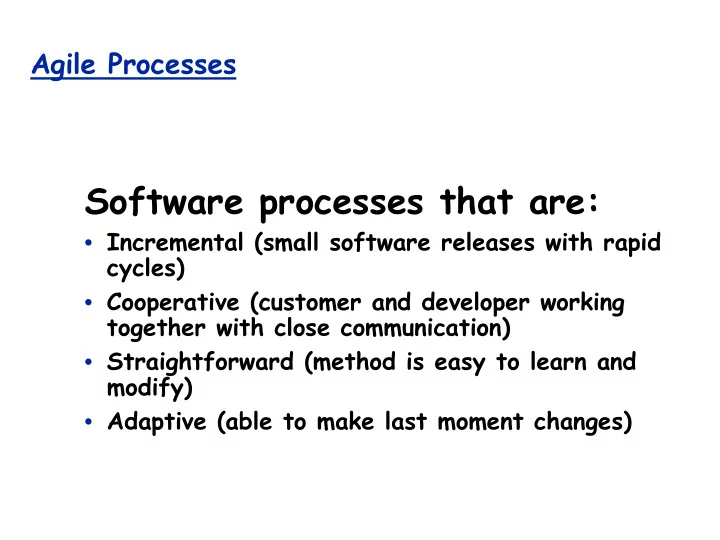

Agile Processes Software processes that are: • Incremental (small software releases with rapid cycles) • Cooperative (customer and developer working together with close communication) • Straightforward (method is easy to learn and modify) • Adaptive (able to make last moment changes)
Objectives • To introduce the notion of an agile process • To describe a number of different agile processes • To pinpoint the advantages and disadvantages of agile processes
Manifesto • Values individuals and interactions over processes and tools • Working software over comprehensive documentation • Customer collaboration over negotiation • Responding to change over following a plan
Agility • Readiness for motion • Nimbleness • Activity • Dexterity in motion
Principles of agility • Customer satisfaction at early stage, continuous delivery of software • Accommodate changing requirements • Deliver working software frequently • Business people and developers work together daily • Build projects around motivated individuals
Principles of agility • Face-to-face conversation as most effective communication • Working software – primary measure of progress • Sustainable development • Continuous attention to technical excellence and good design practices • Self-organizing teams • Proactive process improvement
Human factors • Competence • Common focus • Collaboration • Decision-making ability • Fuzzy problem-solving activity • Mutual trust and respect • Self-organization
Comparison topics • Process • Roles and responsibilities • Practices • Adoption and experiences • Scope of use
Agile methods Extreme programming or XP (Beck 1999) • Scrum (Schwaber and Beedle 1995, 2002) • Crystal family (Cockburn 2002) • Feature Driven Development (Palmer and • Felsing 2002) Rational Unified Process (Kruchten 1996, • 2000) Dynamic Systems Development Method • (Stapleton 1997) Adaptive Software Development (Highsmith • 2000) Open Source Software Development (O’Reilly • 1999)
Extreme Programming (XP) • The most widely used agile process, originally proposed by Kent Beck • XP Planning • Begins with the creation of “user stories” • Agile team assesses each story and assigns a cost • Stories are grouped to for a deliverable increment • A commitment is made on delivery date • After the first increment “project velocity” is used to help define subsequent delivery dates for other increments
Extreme Programming (XP) XP Design • Follows the “keep as simple as possible” principle • Encourage the use of CRC cards • For difficult design problems, suggests the creation of • “spike solutions”—a design prototype Encourages “refactoring”—an iterative refinement of the • internal program design XP Coding • Recommends the construction of a unit test before coding • commences Encourages “pair programming” • XP Testing • All unit tests are executed daily • “Acceptance tests” are defined by the customer and • executed to assess customer visible functionality
Adaptive Software Development • Originally proposed by Jim Highsmith • ASD — distinguishing features • Mission-driven planning • Component-based focus • Uses “time-boxing” (See Chapter 24) • Explicit consideration of risks • Emphasizes collaboration for requirements gathering • Emphasizes “learning” throughout the process
Dynamic Systems Development Method • Promoted by the DSDM Consortium • DSDM—distinguishing features • Similar in most respects to XP and/or ASD • Nine guiding principles • Active user involvement is imperative. • DSDM teams must be empowered to make decisions. • The focus is on frequent delivery of products. • Fitness for business purpose is the essential criterion for acceptance of deliverables. • Iterative and incremental development is necessary to converge on an accurate business solution. • All changes during development are reversible. • Requirements are baselined at a high level • Testing is integrated throughout the life-cycle.
Scrum • Originally proposed by Schwaber and Beedle • Scrum—distinguishing features • Development work is partitioned into “packets” • Testing and documentation are on-going as the product is constructed • Work occurs in “sprints” and is derived from a “backlog” of existing requirements • Meetings are very short and sometimes conducted without chairs • “demos” are delivered to the customer with the time-box allocated
Crystal • Proposed by Cockburn and Highsmith • Crystal—distinguishing features • Actually a family of process models that allow “maneuverability” based on problem characteristics • Face-to-face communication is emphasized • Suggests the use of “reflection workshops” to review the work habits of the team
Feature Driven Development • Originally proposed by Peter Coad et al • FDD—distinguishing features • Emphasis is on defining “features” a feature “is a client-valued function that • can be implemented in two weeks or less.” • Uses a feature template • <action> the <result> <by | for | of | to> a(n) <object> • A features list is created and “plan by feature” is conducted • Design and construction merge in FDD
Agile Modeling • Originally proposed by Scott Ambler • Suggests a set of agile modeling principles • Model with a purpose • Use multiple models • Travel light • Content is more important than representation • Know the models and the tools you use to create them • Adapt locally
Key points Agile processes geared towards • organizational and human aspects of software processes No details about ensuring artifact • consistency and correctness No elaboration or guidelines for the methods • of transforming or producing output artifacts based on the input artifacts Is it appropriate for mission-critical • software development ?
Recommend
More recommend